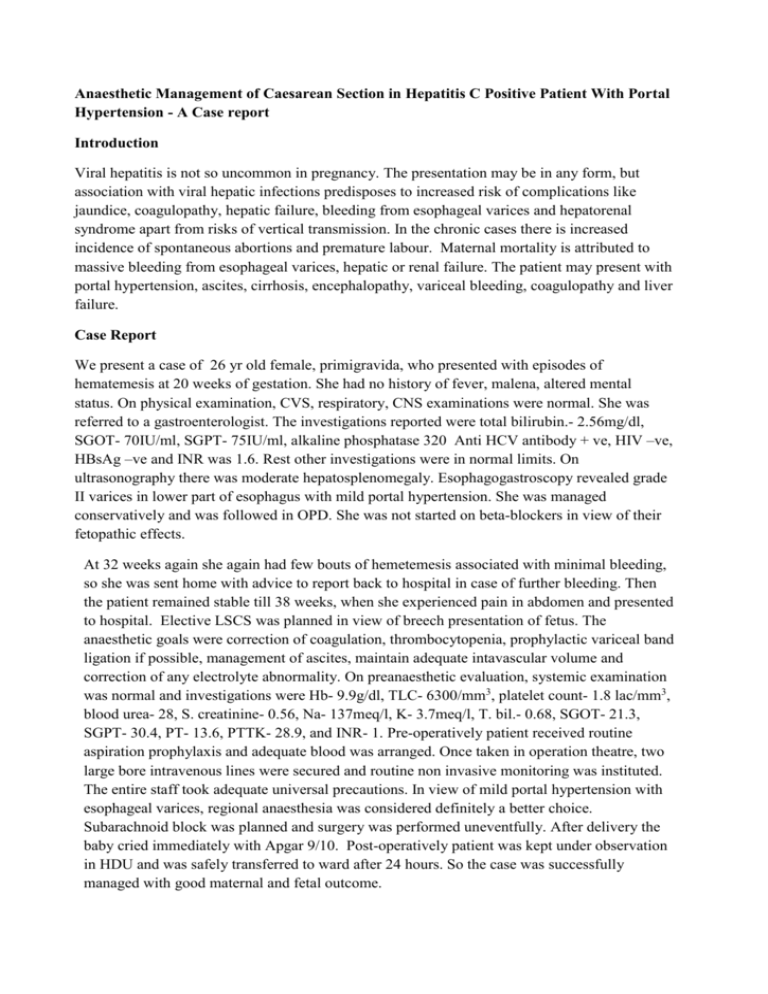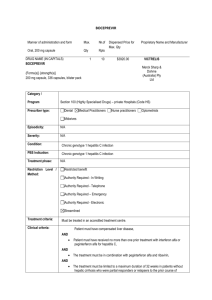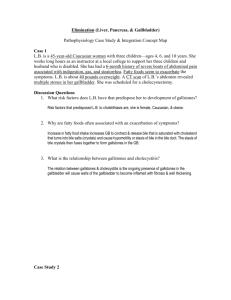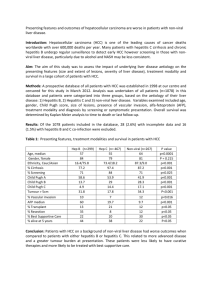Anaesthetic Management of Caesarean Section in Hepatitis
advertisement

Anaesthetic Management of Caesarean Section in Hepatitis C Positive Patient With Portal Hypertension - A Case report Introduction Viral hepatitis is not so uncommon in pregnancy. The presentation may be in any form, but association with viral hepatic infections predisposes to increased risk of complications like jaundice, coagulopathy, hepatic failure, bleeding from esophageal varices and hepatorenal syndrome apart from risks of vertical transmission. In the chronic cases there is increased incidence of spontaneous abortions and premature labour. Maternal mortality is attributed to massive bleeding from esophageal varices, hepatic or renal failure. The patient may present with portal hypertension, ascites, cirrhosis, encephalopathy, variceal bleeding, coagulopathy and liver failure. Case Report We present a case of 26 yr old female, primigravida, who presented with episodes of hematemesis at 20 weeks of gestation. She had no history of fever, malena, altered mental status. On physical examination, CVS, respiratory, CNS examinations were normal. She was referred to a gastroenterologist. The investigations reported were total bilirubin.- 2.56mg/dl, SGOT- 70IU/ml, SGPT- 75IU/ml, alkaline phosphatase 320 Anti HCV antibody + ve, HIV –ve, HBsAg –ve and INR was 1.6. Rest other investigations were in normal limits. On ultrasonography there was moderate hepatosplenomegaly. Esophagogastroscopy revealed grade II varices in lower part of esophagus with mild portal hypertension. She was managed conservatively and was followed in OPD. She was not started on beta-blockers in view of their fetopathic effects. At 32 weeks again she again had few bouts of hemetemesis associated with minimal bleeding, so she was sent home with advice to report back to hospital in case of further bleeding. Then the patient remained stable till 38 weeks, when she experienced pain in abdomen and presented to hospital. Elective LSCS was planned in view of breech presentation of fetus. The anaesthetic goals were correction of coagulation, thrombocytopenia, prophylactic variceal band ligation if possible, management of ascites, maintain adequate intavascular volume and correction of any electrolyte abnormality. On preanaesthetic evaluation, systemic examination was normal and investigations were Hb- 9.9g/dl, TLC- 6300/mm3, platelet count- 1.8 lac/mm3, blood urea- 28, S. creatinine- 0.56, Na- 137meq/l, K- 3.7meq/l, T. bil.- 0.68, SGOT- 21.3, SGPT- 30.4, PT- 13.6, PTTK- 28.9, and INR- 1. Pre-operatively patient received routine aspiration prophylaxis and adequate blood was arranged. Once taken in operation theatre, two large bore intravenous lines were secured and routine non invasive monitoring was instituted. The entire staff took adequate universal precautions. In view of mild portal hypertension with esophageal varices, regional anaesthesia was considered definitely a better choice. Subarachnoid block was planned and surgery was performed uneventfully. After delivery the baby cried immediately with Apgar 9/10. Post-operatively patient was kept under observation in HDU and was safely transferred to ward after 24 hours. So the case was successfully managed with good maternal and fetal outcome. Discussion In chronic liver diseases, the fertility rate decreases. [1] Though pre-existing liver disease is not a contra-indication for pregnancy, still it requires intensive monitoring throughout the antenatal period. The patient is predisposed to numerous complications in view of physiological changes accompanying pregnancy in addition to preexisting liver pathology. Such patients require multidisciplinary consultation for medical optimization of the patient. Aggarwal et al reviewed 9 pregnancies out of which 7 had cirrhosis complicated with jaundice, ascites with and without hemetemesis out of which only 2 patients underwent endoscopic sclerotherapy. [2] Successful outcome of a pregnancy in a woman with advanced cirrhosis due to hepatitis B infection, delta super-infection and hepatitis C co-infection has been reported by Subhan et al[3].The patient had normal vaginal delivery with healthy baby. Acute viral hepatitis can occur in any trimester of pregnancy, but is most severe in third trimester of the pregnancy. Prevalence of hepatitis A, B and C is similar in obstetric as well as non-obstetric females and incidence of Hepatitis E is more in pregnancy. Hepatitis C affects 0.51.4% of population. [4] Chronic hepatitis C requires no more than symptomatic management, but definitely predisposes to risk of transmission to offspring. The risk of transmission of hepatitis C is 6–10% and depends on the mother’s level of blood viremia that is if RNA titres are more than 106 [5]. HIV co-infection is also considered to increase the risk of vertical transmission. The incidence of hepatitis C and D doubles with hepatitis B coinfection and combined incidence was reported to be 3.1%.[6] In spite of fast progressing technology, no effective immunoprophylaxis is available till this date for lowering this risk. Even administration of gamma globulins also provides no protection against transmission. It has been clearly demonstrated by Lin et al that breast feeding is safe for the offspring of mothers with hepatitis B as well as hepatitis C once appropriately immunized. [7] In our case, presence of portal hypertension along with hemetemesis from esophageal varices further complicated the case. Portal hypertension with cirrhosis compounds the physiological increase in circulating blood volume associated with pregnancy. Any elevation in portal pressure with added pressure from the gravid uterus on the IVC predisposed the patient for hemetemesis. In fact massive bleeding is most common during the second trimester with 20–27% chance of bleeding from esophageal varices, which is amplified to 62–78% if there are demonstrable varices. [2,8]. With HCV infection, the patients remain asymptomatic in 75%, present with acute manifestations in 24% and fulminant hepatitis in only 1%.[2] Further incidence of chronic hepatitis is 80%, of cirrhosis is 35% and only 5% may progress to hepatocellular carcinoma. The diagnostic tests include anti HCV antibodies (ELISA and RIBA) and HCV RNA PCR. The treatment includes interferon and ribavirin but is contraindicated in pregnancy. At present no vaccine is available. Massive bleeding from esophageal varices is one of the most common cause of maternal death. [9]. It may be further aggravated by deranged co-agulation and thrombocytopenia. In non obstetric population, variceal band ligation [10], sclerotherapy, portosystemic shunting, somatostatin and beta-blockers definitely play a role. The mode of delivery, vaginal or caesarean section, have no effect on risk of transmission. And in fact it is the stage of the liver disease which is most important determinant of outcome of pregnancy. The plan for caesarean section in such females mandates proper pre-anaesthetic evaluation, relevant history, related investigations and optimization depending on time of presentation. The anaesthesiologist, gastro-enterologist and surgeons should be consulted as soon as patient presents in antenatal period. It not only ensures maternal and fetal well being, but also helps in prevention of complications. During regular follow – ups, early detection of complications if any leads to better optimization, hence decreased morbidity and mortality. If the antenatal period is uneventful and condition of mother is good, the fetal outcome is generally good. The anaesthetic concerns include correction of coagulation, thrombocytopenia, electrolyte imbalance if any, maintain adequate intravascular volume and hematocrit. Consideration has been given to pharmacokinetic and pharmacodynamic changes which may include altered volume of distribution due to decreased serum albumin, increased globulins and unpredictable intravascular volume. [8] Portosystemic shunted blood bypasses liver, so drugs highly extracted by liver are generally affected. There may be increased sensitivity to sedative medications. Under all circumstances preserve hepatic blood flow. Avoid halothane and isoflurane is considered to be better as far as hepatic circulation is concerned. Consider regional anesthesia, where ever feasible. Avoid medications with potential hepatotoxicity like halothane, acetaminophen, sulfonamides and amiodarone. In presence of esophageal varices, avoid blind instrumentation of esophagus. There is no way to decrease the incidence of fetal transmission and there are chances that infected neonates may develop chronic hepatitis. So, one must perform postoperative surveillance clinically as well as biochemically. References 1. Russel MA, Craigo SD. Cirrhosis and portal hypertension in pregnancy. Seminars in perinatology. 1998;22(2):156-165 2. Aggarwal N, Sawnhey H, Suril V, Vasishta K, Jha M, Dhiman RK. Pregnancy and cirrhosis of the liver. Aust N Z J Obstet Gynaecol. 1999 Nov;39(4):503-6. 3. Subhan A, Abid S, Jafri W. Successful outcome of a pregnancy in a woman with advanced cirrhosis due to hepatitis B surface antigenemia, delta super-infection and hepatitis C coinfection: a case report. J Med Case Rep 2007;1:96. 4. Shepard CW, Finelli L, Alter MJ. Global epidemiology of hepatitis C virus infection. Lancet Infect Dis 2005;5:558-67 5. Ohto H, Terazawa S, Sasaki N, et al. Transmission of hepatitis C virus from mothers to infants. N Engl J Med 1994;330:744–50. 6. Baig S, Siddiqui AA, Ahmed WU, Qureshi H, Arif A. Frequency of hepatitis C and D super infection in patients with hepatitis B related complex liver disorders. J Coll Physicians Surg Pak. 2009;19(11):699-703 7. Lin H, Kao J, JY J, et al. Absence of infection in breast-fed infants born to hepatitis C virusinfected mothers. J Pediatr 1995;126:589–91 8. David H Chestnut. Obstetric Anesthesia – Principles and practice. 3rd edition. Philadelphia: Elsevier; 2009. 9. Sobral M, Granya C, Sampaio M, Guerreiro F. Bleeding from esophageal varices in pregnancy. BMJ Case Reports 2013 10. Zeeman GG, Moise KJ Jr. Prophylactic bandingof severe esophageal varices with liver cirrhosis in pregnancy. Obstet Gynecol 1999;94:842








